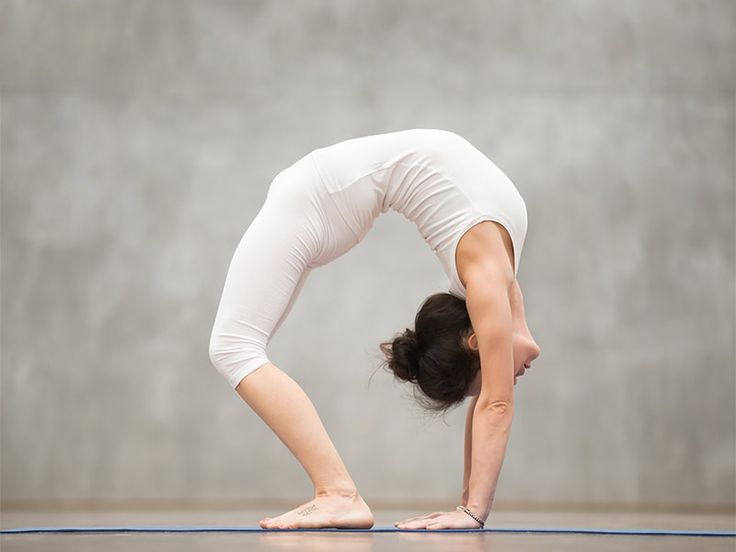Chakrasana : Wheel Pose
Chakrasana, also known as the Wheel Pose, is a dynamic backbend that mirrors the shape of a wheel. This asana is derived from the Sanskrit words “Chakra,” meaning “wheel,” and “Asana,” meaning “pose.” It is a pivotal pose in yoga practice, reflecting the essence of transformation and vitality. Traditionally, Chakrasana is believed to activate the spinal energy centers or chakras, facilitating the free flow of life force or prana throughout the body. This asana is not just a physical posture but a bridge to deeper spiritual awakening, symbolizing the cycle of creation and the continuous flow of energy in the universe. By practicing Chakrasana, individuals embark on a journey of self-discovery, exploring the limits of their physical and mental boundaries.

Practice Steps
Preparatory Poses:
Before attempting Chakrasana, it’s crucial to warm up the body with preparatory poses such as the Cobra Pose (Bhujangasana), Camel Pose (Ustrasana), and Bridge Pose (Setu Bandhasana). These asanas help to stretch the front body, strengthen the back, and prepare the spine for the deep backbend.
Step-by-Step Guide:
1.Starting Position:
- Begin by lying flat on your back on a yoga mat, with your feet hip-width apart and close to your sitting bones. Bend your knees and place your feet firmly on the ground. Bring your hands next to your ears, with your fingers pointing towards your shoulders.
2.Lifting Up:
- Inhale deeply, pressing your palms and feet into the ground, and lift your hips and spine off the floor. Keep pushing until your arms are straight, and your body forms an arch resembling a wheel.
3.Alignment and Breath:
- Ensure your thighs and inner feet are parallel. Press evenly into your hands and feet, lifting your chest further away from the ground. Breathe steadily, holding the pose for 15 to 30 seconds, depending on your comfort level.
4.Coming Out of the Pose:
- To release, exhale slowly and lower your body back to the ground, tucking your chin into your chest last. Hug your knees into your chest gently to release any tension in the back.
Tips for Beginners:
- Start with the Bridge Pose to build strength in your back and legs.
- Use a yoga block under your palms or feet if you cannot fully straighten your arms or if your feet do not firmly reach the ground.
- Practice near a wall to prevent falling backward.
Benefits of Chakrasana (Wheel Pose)
Physical Benefits:
- Strengthens the Spine: Regular practice of Chakrasana enhances the flexibility and strength of the spine, counteracting the effects of prolonged sitting and standing postures that lead to stiffness and back pain.
- Stimulates the Thyroid Gland: The intense extension of the neck and throat in this pose helps in stimulating the thyroid glands, aiding in the regulation of metabolic functions.
- Heart Opener: This asana acts as a powerful heart opener, expanding the chest and lungs, which improves breathing capacity and alleviates respiratory issues.
- Energizes the Body: By stretching the front body and strengthening the arms, legs, abdomen, and spine, Chakrasana energizes the entire body, alleviating fatigue.
Mental and Emotional Benefits:
- Relieves Stress and Anxiety: The inversion aspect of the pose, with the heart being higher than the head, has a calming effect on the brain, helping to relieve stress and mild depression.
- Boosts Mood: The backbend stimulates the nervous system, releases endorphins, and often leads to an uplifted mood and increased energy levels, combating feelings of lethargy.
Spiritual Benefits:
- Activates Chakras: Chakrasana is believed to activate the Manipura (Solar Plexus), Anahata (Heart), Vishuddha (Throat), and Ajna (Third Eye) Chakras, facilitating the balance and flow of energy through the body’s energy centers.
- Enhances Creativity and Intuition: By opening the front body and activating the heart and throat chakras, this pose encourages self-expression, creativity, and enhanced intuition.
Precautions and Contraindications
While Chakrasana offers numerous benefits, it’s essential to practice it with caution, especially for beginners or those with specific health conditions.
- Back and Neck Injuries: Individuals with recent or severe back or neck injuries should avoid this pose.
- High or Low Blood Pressure: People with uncontrolled high or low blood pressure should not practice this pose without the guidance of an experienced yoga instructor.
- Heart Conditions: Those with heart conditions should consult with their healthcare provider before attempting this asana.
- Pregnancy: Pregnant women should avoid this pose, especially in the later stages of pregnancy.
Tips for Practicing Safely:
- Always warm up your body with appropriate preparatory poses.
- Practice under the guidance of an experienced yoga instructor.
- Listen to your body and do not push beyond your limits. Use props like blocks and straps to assist you if necessary.
- Ensure to perform counterposes after Chakrasana, such as forward bends, to balance the stretch.
Closing Thoughts
Chakrasana, or Wheel Pose, is more than just a physical posture; it’s a journey into the depths of your inner strength and flexibility. By incorporating this powerful asana into your regular yoga practice, you not only enhance your physical wellbeing but also embark on a path of mental, emotional, and spiritual growth. Remember, the key to a successful practice is consistency, awareness, and patience. Listen to your body, practice with intention, and observe how Chakrasana can transform your yoga practice and your life.
This guide aims to inspire and assist you in safely exploring the dynamic and transformative power of Chakrasana. Whether you’re a beginner or an experienced practitioner, there’s always something new to discover in the journey of yoga. Happy practicing!